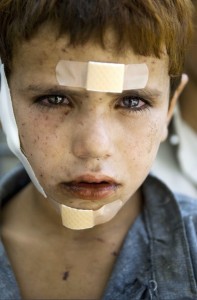We don’t know anything about the gunman in Copenhagen who opened fire today on a cafe where they were holding a panel entitled, “”Art, blasphemy & the freedom of expression.” The event was to mark the 25-year anniversary of the Iranian fatwa against novelist Salman Rushdie. Lars Vilks, a Swedish cartoonist notorious for depicting Mohammed as a dog, & Inna Shevchenko, a leader of FEMEN & open hater of Arabs & Islam, were in attendance but unharmed. One of the guises Islamophobia now uses is apparently freedom of art & expression.
One wonders why after Charlie Hebdo such an event would not be surrounded by a phalanx of security guards but it may have beefed up security since three cops were injured in the melee. Or were they the security guards Vilks now travels with? The Danish Prime Minister called it “a political assassination & thus a terrorist attack.” Nothing like a rush to judgement since they still haven’t apprehended the gunman & don’t know his motives.
We know there are extremists & psychos who identify with Islam; there are plenty of psychos who identify with Christianity (witness the Westboro church)–not to mention who identify with socialism. Until they apprehend the shooter we don’t know who he is or what motivates him. It’s very likely they’ll corner the guy & take him out because dead men don’t talk & they can make up any story they like. That isn’t apologetics nor is it conspiracy theory. Islamophobia is the gestalt of neoliberal capitalism justifying it’s many wars. Setting up loose cannons to pull this kind of action off is what agents provocateurs do.
We leave crime-solving to the Danish police. What matters to defenders of civil liberties is how this incident will be used against Muslims around the world. Already an Oregon talk show host said, “Muslims killing in the name of blasphemy has to stop! They either learn to live in a pluralistic society or we need to remove them from that society as an act of self defense.” That inflammatory statement is a call to violence for the loose cannons who hate Muslims & love war.
The only way to turn this tsunami of hatred back is to stand against the wars justified by Islamophobia & to stand with Palestinians. There are spring antiwar marches planned demanding “No US wars in Afghanistan & Iraq!” There will be rallies & forums building the economic & cultural boycott of Israel. Be there or be square.
